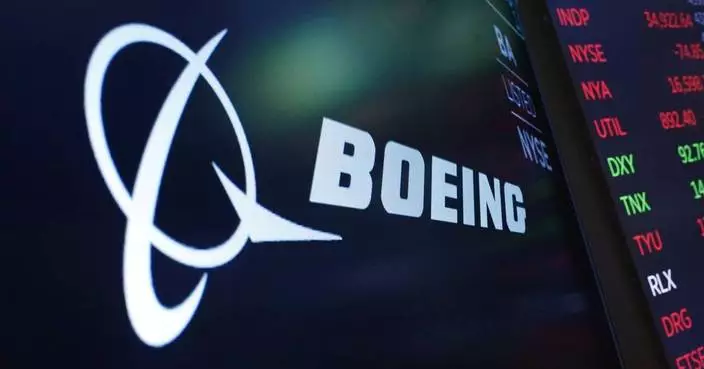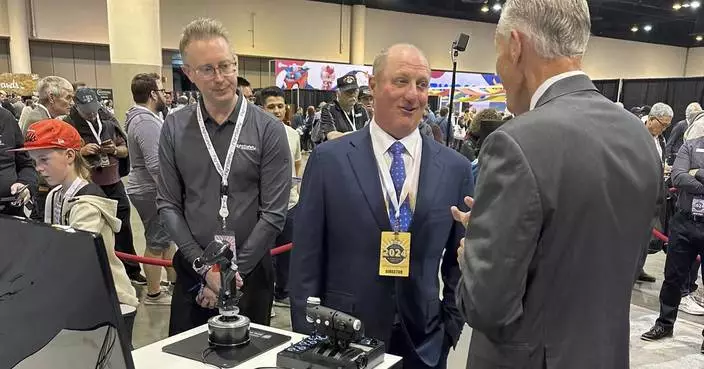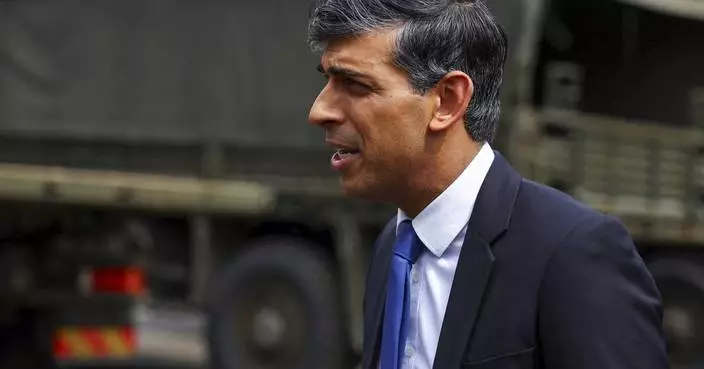NEW YORK (AP) — Legislation forcing TikTok's parent company to sell the video-sharing platform or face a ban in the U.S. received President Joe Biden's official signoff Wednesday. But the newly minted law could be in for an uphill battle in court.
Critics of the sell-or-be-banned ultimatum argue it violates TikTok users' First Amendment rights. The app's China-based owner, ByteDance, has already promised to sue, calling the measure unconstitutional.
But a court challenge's success is not is not guaranteed. The law's opponents, which include advocacy organizations like the American Civil Liberties Union, maintain that the government hasn't come close to justifying banning TikTok, while others say national-security claims could still prevail.
For years, lawmakers on both sides of the aisle have expressed concerns that Chinese authorities could force ByteDance to hand over U.S. user data, or influence Americans by suppressing or promoting certain content on TikTok. The U.S. has yet to provide public evidence to support those claims, but some legal experts note that political pressures have piled up regardless.
If upheld, legal experts also stress that the law could set a precedent carrying wider ramifications for digital media in the U.S.
Here's what you need to know.
That's the central question. TikTok and opponents of the law have argued that a ban would violate First Amendment rights of the social media platform's 170 million U.S. users.
Patrick Toomey, deputy director of the ACLU’s National Security Project, said a TikTok ban would “stifle free expression and restrict public access” to a platform that has become central source for information sharing.
Among key questions will be whether the legislation interferes with the overall content of speech on TikTok, notes Elettra Bietti, an assistant professor of law and computer science at Northeastern University, because content-based restrictions meet a higher level of scrutiny.
ByteDance had yet to officially file a lawsuit by late Wednesday, but Bietti said she expects the company's challenge to primarily focus on whether a ban infringes on these wider free-speech rights. Additional litigation involving TikTok's “commercial actors,” such as businesses and influencers who make their living on the platform, may also arise, she added.
TikTok is expressing confidence about the prospects of its planned challenge.
“Rest assured, we aren’t going anywhere,” TikTok CEO Shou Chew said in a video response posted to X Wednesday. “The facts and the Constitution are on our side, and we expect to prevail again.”
Toomey also said that he is optimistic about the possibility of TikTok being able to block the measure in court, noting that both users and the company “have extremely strong" First Amendment claims.
“Many of the calls to completely ban TikTok in the U.S. are about scoring political points and rooted in anti-China sentiment,” Toomey added. “And to date, these steps to ban TikTok had not been remotely supported by concrete public evidence.”
Still, the future of any litigation is hard to predict, especially for this kind of case. And from a legal perspective, legal experts say it can be difficult to cite political motivations, even if they're well-documented, as grounds to invalidate a law.
The battle could also string along for some time, with the potential for appeals that could go all the way to the Supreme Court, which would likely uphold the law due to its current composition, said Gus Hurwitz, a senior fellow at the University of Pennsylvania’s Carey Law School.
TikTok's legal challenge won't go on without a fight. The government will probably respond with national-security claims, which were already cited prominently as the legislation made its way through Congress.
Toomey maintains that the government hasn't met the high bar required to prove imminent national-security risks, but some other legal experts note that it's still a strong card to play.
“One of the unfortunate and really frustrating things about national-security legislation (is that) it tends to be a trump card,” Hurwitz said. "Once national-security issues come up, they’re going to carry the day either successfully or not."
Hurwitz added that he thinks there are legitimate national-security arguments that could be brought up here. National security can be argued because it's a federal measure, he added. That sets this scenario apart from previously unsuccessful state-level legislation seeking to ban TikTok, such as in Montana.
But national-security arguments are also vulnerable to questioning as to why TikTok is getting specific scrutiny.
“Personally, I believe that what TikTok does isn’t that different from other companies that are U.S.-based,” Bietti said, pointing to tech giants ranging from Google to Amazon. “The question is, ‘Why ban TikTok and not the activities and the surveillance carried out by other companies in the United States?’”
Still, legal experts note that there could be repercussions beyond TikTok in the future.
The measure was passed as part of a larger $95 billion package that provides aid to Ukraine and Israel. The package also includes a provision that makes it illegal for data brokers to sell or rent “personally identifiable sensitive data” to North Korea, China, Russia, Iran or entities in those countries.
That has encountered some pushback, including from the ACLU, which says the language is written too broadly and could sweep in journalists and others who publish personal information.
“There’s real reason to be concerned that the use of this law will not stop with TikTok,” Toomey said. “Looking at that point and the bigger picture, banning TikTok or forcing its sale would be a devastating blow to the U.S. government’s decades of work promoting an open and secure global internet.”

FILE - The TikTok logo is displayed on a mobile phone in front of a computer screen, Oct. 14, 2022, in Boston. A measure set to force TikTok's parent company to sell the video-sharing platform or face a ban in the U.S. received President Joe Biden's official sign-off on Wednesday, April 24, 2024. But the newly-minted law could soon face an uphill battle in court. (AP Photo/Michael Dwyer, File)
CAPE CANAVERAL, Fla. (AP) — After years of delays and stumbles, Boeing is finally poised to launch astronauts to the International Space Station for NASA.
It’s the first flight of Boeing’s Starliner capsule with a crew on board, a pair of NASA pilots who will check out the spacecraft during the test drive and a weeklong stay at the space station.
NASA turned to U.S. companies for astronaut rides after the space shuttles were retired. Elon Musk's SpaceX has made nine taxi trips for NASA since 2020, while Boeing has managed only a pair of unoccupied test flights.
Boeing program manager Mark Nappi wishes Starliner was further along. “There’s no doubt about that, but we’re here now.”
The company's long-awaited astronaut demo is slated for liftoff Monday night.
Provided this tryout goes well, NASA will alternate between Boeing and SpaceX to get astronauts to and from the space station.
A look at the newest ride and its shakedown cruise:
White with black and blue trim, Boeing's Starliner capsule is about 10 feet (3 meters) tall and 15 feet (4.5 meters) in diameter. It can fit up to seven people, though NASA crews typically will number four. The company settled on the name Starliner nearly a decade ago, a twist on the name of Boeing’s early Stratoliner and the current Dreamliner.
No one was aboard Boeing’s two previous Starliner test flights. The first, in 2019, was hit with software trouble so severe that its empty capsule couldn’t reach the station until the second try in 2022. Then last summer, weak parachutes and flammable tape cropped up that needed to be fixed or removed.
Veteran NASA astronauts Butch Wilmore and Suni Williams are retired Navy captains who spent months aboard the space station years ago. They joined the test flight after the original crew bowed out as the delays piled up. Wilmore, 61, is a former combat pilot from Mount Juliet, Tennessee, and Williams, 58, is a helicopter pilot from Needham, Massachusetts. The duo have been involved in the capsule’s development and insist Starliner is ready for prime time, otherwise they would not strap in for the launch.
“We’re not putting our heads in the sand,” Williams told The Associated Press. “Sure, Boeing has had its problems. But we are the QA (quality assurance). Our eyes are on the spacecraft.”
Starliner will blast off on United Launch Alliance’s Atlas V rocket from Cape Canaveral Space Force Station. It will be the first time astronauts ride an Atlas since NASA’s Project Mercury, starting with John Glenn when he became the first American to orbit the Earth in 1962. Sixty-two years later, this will be the 100th launch of the Atlas V, which is used to hoist satellites as well as spacecraft.
“We’re super careful with every mission. We’re super, duper, duper careful" with human missions, said Tory Bruno, CEO of ULA, a joint venture of Boeing and Lockheed Martin.
Starliner should reach the space station in roughly 26 hours. The seven station residents will have their eyes peeled on the approaching capsule. The arrival of a new vehicle is "a really big deal. You leave nothing to chance,” NASA astronaut Michael Barratt told the AP from orbit. Starliner will remain docked for eight days, undergoing checkouts before landing in New Mexico or elsewhere in the American West.
Both companies’ capsules are designed to be autonomous and reusable. This Starliner is the same one that made the first test flight in 2019. Unlike the SpaceX Dragons, Starliner has traditional hand controls and switches alongside touchscreens and, according to the astronauts, is more like NASA’s Orion capsules for moon missions. Wilmore and Williams briefly will take manual control to wring out the systems on their way to the space station.
NASA gave Boeing, a longtime space contractor, more than $4 billion to develop the capsule, while SpaceX got $2.6 billion. SpaceX already was in the station delivery business and merely refashioned its cargo capsule for crew. While SpaceX uses the boss' Teslas to get astronauts to the launch pad, Boeing will use a more traditional “astrovan” equipped with a video screen that Wilmore said will be playing “Top Gun: Maverick.”
One big difference at flight’s end: Starliner lands on the ground with cushioning airbags, while Dragon splashes into the sea.
Boeing is committed to six Starliner trips for NASA after this one, which will take the company to the station’s planned end in 2030. Boeing’s Nappi is reluctant to discuss other potential customers until this inaugural crew flight is over. But the company has said a fifth seat will be available to private clients. SpaceX periodically sells seats to tycoons and even countries eager to get their citizens to the station for a couple weeks.
Coming soon: Sierra Space’s mini shuttle, Dream Chaser, which will deliver cargo to the station later this year or next, before accepting passengers.
The Associated Press Health and Science Department receives support from the Howard Hughes Medical Institute’s Science and Educational Media Group. The AP is solely responsible for all content.

Boeing's Starliner capsule atop an Atlas V rocket is rolled out to the launch pad at Space Launch Complex 41, Saturday, May 4, 2024, in Cape Canaveral, Fla. NASA astronauts Butch Wilmore and Suni Williams will launch aboard to the International Space Station, scheduled for liftoff on May 6, 2024. (AP Photo/Terry Renna)

Boeing's Starliner capsule atop an Atlas V rocket is rolled out to the launch pad at Space Launch Complex 41, Saturday, May 4, 2024, in Cape Canaveral, Fla. NASA astronauts Butch Wilmore and Suni Williams will launch aboard to the International Space Station, scheduled for liftoff on May 6, 2024. (AP Photo/Terry Renna)
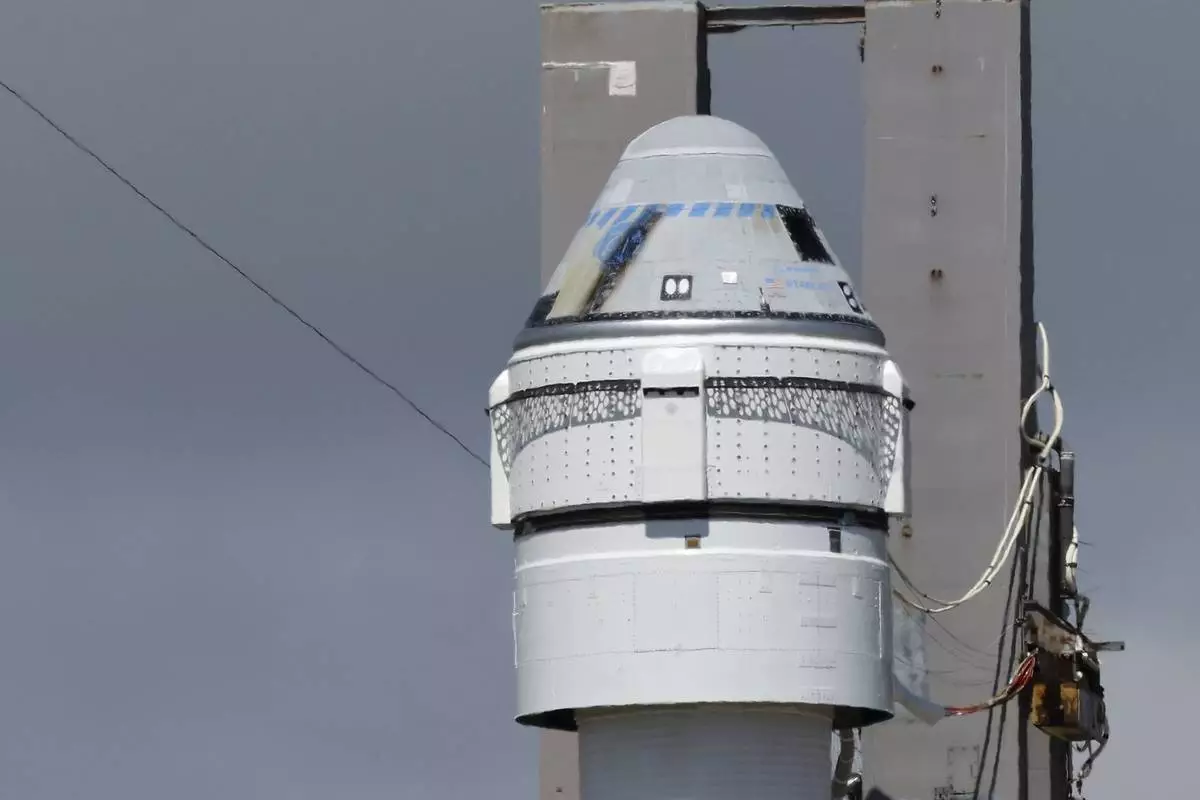
Boeing's Starliner capsule atop an Atlas V rocket is rolled out to the launch pad at Space Launch Complex 41, Saturday, May 4, 2024, in Cape Canaveral, Fla. NASA astronauts Butch Wilmore and Suni Williams will launch aboard to the International Space Station, scheduled for liftoff on May 6, 2024. (AP Photo/Terry Renna)
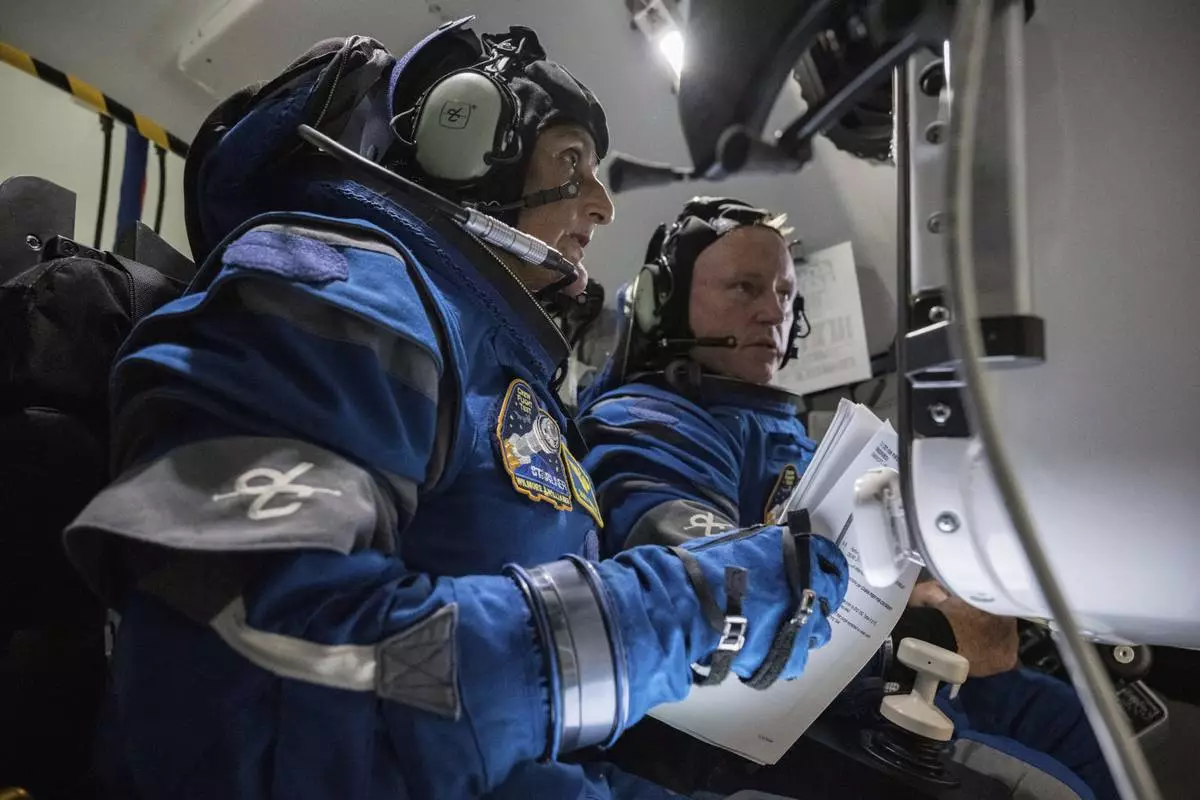
Boeing Crew Flight Test crew members Suni Williams and Butch Wilmore work in the Boeing Starliner simulator at the Johnson Space Center in Houston on Nov. 3, 2022. The first flight of Boeing’s Starliner capsule with a crew on board is scheduled for Monday, May 6, 2024. (NASA/Robert Markowitz)
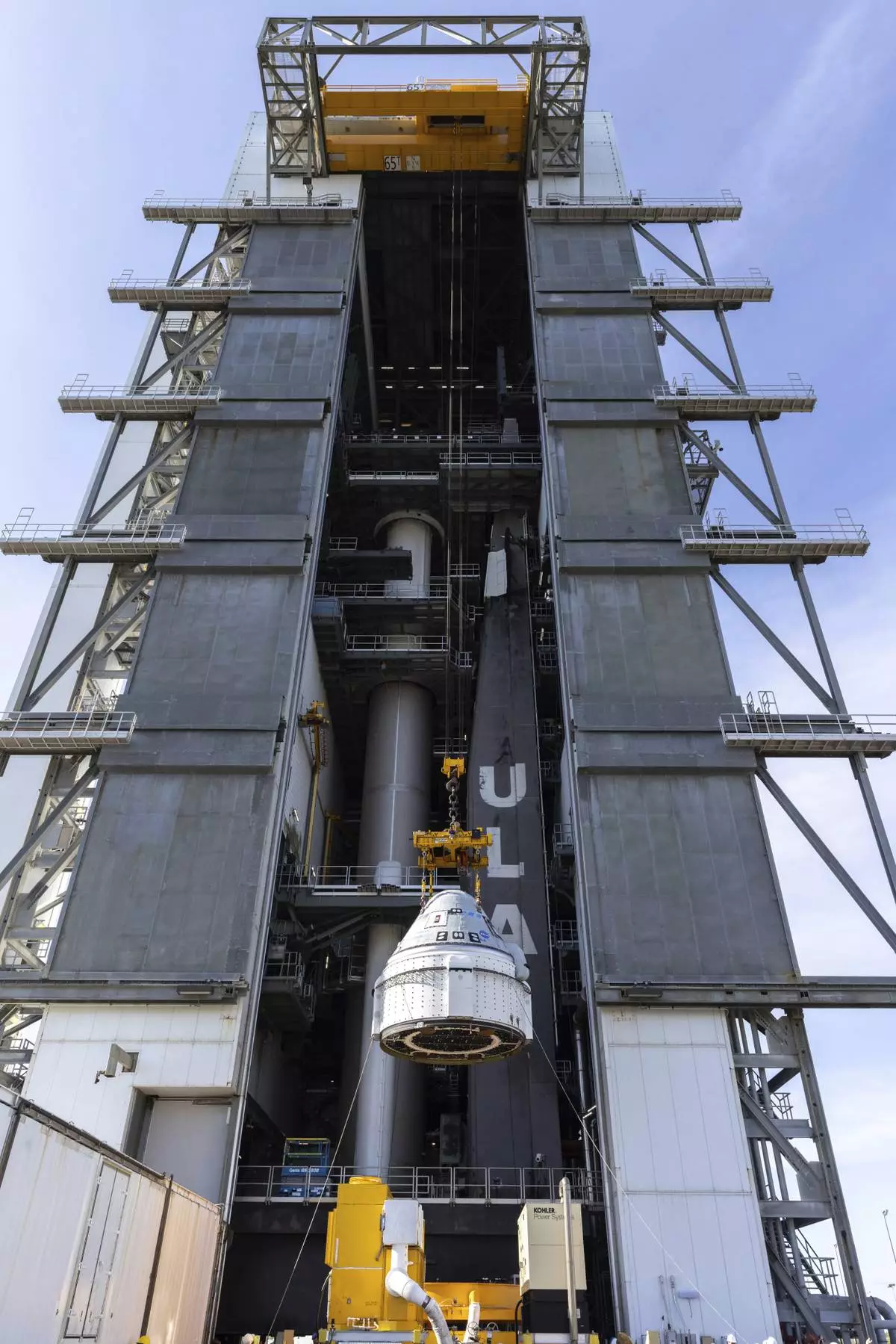
In this photo provided by NASA, the Boeing Starliner spacecraft is lifted at the Vertical Integration Facility at Space Launch Complex-41 at Cape Canaveral Space Force Station in Florida on Tuesday, April 16, 2024, for mounting on a United Launch Alliance Atlas V rocket for NASA's Boeing Crew Flight Test to the International Space Station for the agency's Commercial Crew Program. The first flight of Boeing’s Starliner capsule with a crew on board is scheduled for Monday, May 6, 2024. (Kim Shiflett/NASA via AP)

NASA's Boeing Crew Flight Test astronauts Suni Williams and Butch Wilmore exit the Neil A. Armstrong Operations and Checkout Building at the agency's Kennedy Space Center in Florida during a mission dress rehearsal on Friday, April 26, 2024. The first flight of Boeing’s Starliner capsule with a crew on board is scheduled for Monday, May 6, 2024. (Frank Micheaux/NASA via AP)
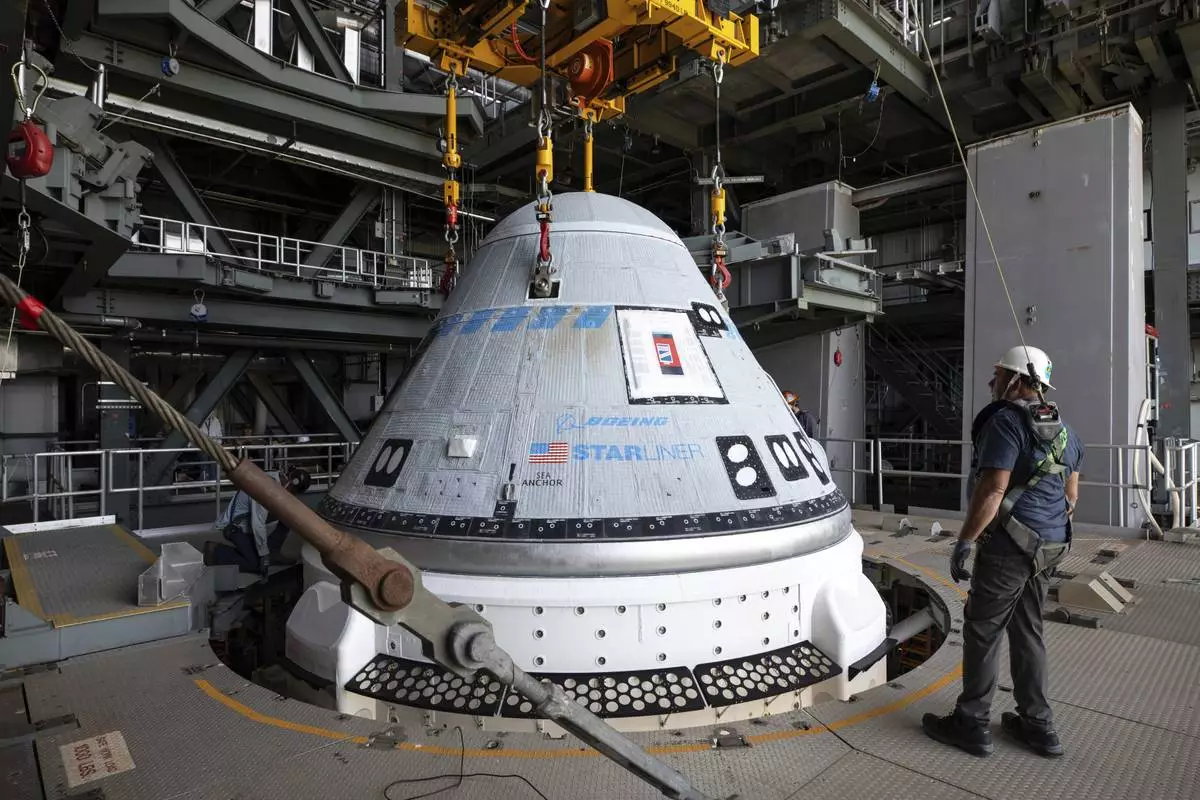
In this photo provided by NASA, the Boeing Starliner spacecraft is lifted at the Vertical Integration Facility at Space Launch Complex-41 at Cape Canaveral Space Force Station in Florida on Tuesday, April 16, 2024, for mounting on a United Launch Alliance Atlas V rocket for NASA's Boeing Crew Flight Test to the International Space Station for the agency's Commercial Crew Program. The first flight of Boeing’s Starliner capsule with a crew on board is scheduled for Monday, May 6, 2024. (Kim Shiflett/NASA via AP)














